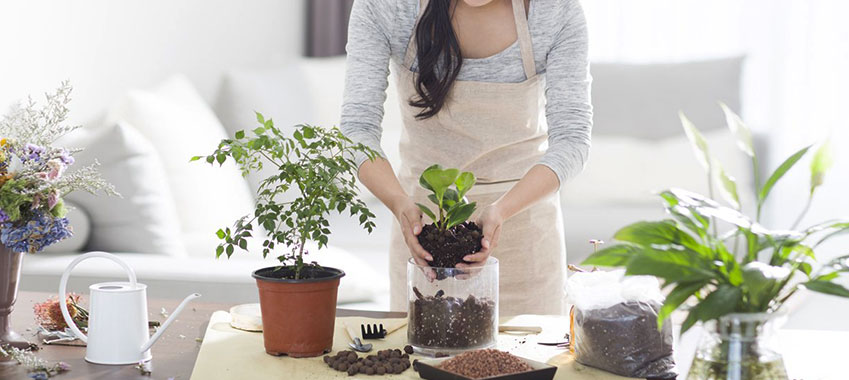12
Feb
1. First of all you have to choose the pots.
Remember choose that kind of pot in which there are one or more holes in the bottom of your container to allow water to flow out freely. Insufficient drainage can cause roots to drown, and the plant to die prematurely.
You can use anything as a container for plants, so what type of pot you choose its all yo to you your style preference and budget.
2. Choose the potting mix.
Do not use soil from the yard or garden. Because It can be filled with weed seeds, insects, and fungal diseases.
Buy potting soil at your local garden center. It is a loose and light mixture of materials like peat moss, vermiculite, and, often, decomposed organic matter. If you are planting succulents or cacti, use a mix especially formulated for them.
3. Select the plants.
Select the plant according to your condition of your space Make “Right plant, right place”. Don’t try to grow a flower like a rose―which requires six hours of full sun―on a porch that gets only an hour in the early morning if you have that kind space in your home than you should choose rose plant
If you choose to combine multiple types of plants, make sure they all like the same light and moisture conditions. Don’t put a cactus and a pansy together in one pot and expect them to get along.
4. Prepare the pots.
If your containers are large, place them where they’ll ultimately go before filling them. Once they are full and watered, they may be too heavy to move.
Put a basket-type coffee filter or a shard of broken pot over the hole in the bottom of the empty pot. This will prevent the potting mix from washing out but will still allow water to escape.
Before pouring in the soil, check its moisture content. Read directions on the bag for wetting it properly. Generally, you need to add water a little at a time and knead the mixture with your hands. A good rule of thumb is to wet the mix until it feels like a damp sponge.
Fill the container with the soil. Put in enough potting mix so the base of the plant (where the stem sprouts from the soil’s surface) is about 1 inch from the top of the pot (to help visually estimate, position your plant while it’s still in its nursery container). Before planting, pat down the soil lightly with your fingers to eliminate any big air pockets. Don’t pack it down too hard.
5. Pot the plant.
Remove the plant from its nursery container. (It’s a good practice to water plants in their original containers at least an hour before transplanting. This will ease their removal and diminish transplant shock.) Support the top of the “root ball” (the semisolid mass of soil and roots) by placing a finger on each side of the stem; then tip the pot and let the plant fall gently into your hand. Never pull a plant out by its stem. If it is stuck, tap the sides of the pot to loosen it.
If the roots are circling around and around, the plant is “root-bound.” Gently tease the ends of the roots free before planting.

Lorem Ipsum is simply dummy text of the printing and typesetting industry. Lorem Ipsum has been the industry’s standard dummy text ever since the 1500s, when an unknown.
dsfasdfdsag
Lorem Ipsum is simply dummy text of the printing and typesetting industry. Lorem Ipsum has been the industry’s standard dummy text ever since the 1500s, when an unknown.
dâsdgafga
Lorem Ipsum is simply dummy text of the printing and typesetting industry. Lorem Ipsum has been the industry’s standard dummy text ever since the 1500s, when an unknown.Comment
Lorem Ipsum is simply dummy text of the printing and typesetting industry. Lorem Ipsum has been the industry’s standard dummy text ever since the 1500s, when an unknown.Comment